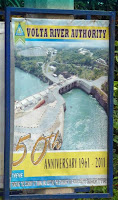 |
| Akosombo Dam and Volta Lake, Ghana |
Blog Entry #17: Ghana Moves Forward II: Development, Conservation, and Rising Populations
Saturday, September 17, 2011
Our final day in Ghana found me leading my second “FDP” – Faculty Developed Practicum – or class-affiliated field trip. In this case I was co-leading a trip with my geologist colleague, Alan Goldin, to the Akosombo Dam and the Shai Hills Nature Reserve NE of Accra, to look at the intersection of geology and ecology with economic development and nature conservation issues.
Begun in 1961 and completed in 1966, the Akosombo Dam on the Volta River created Volta Lake: 3275 square miles, over 5000 miles of shoreline and nearly 250 miles in length, the world’s largest artificial reservoir until the recent completion of the Three Gorges Dam in China.
A model of World Bank sponsored and funded development typical of the 1960s – large hydroelectric dams to fuel economic development through energy, irrigation, and fishing – the Akosombo Dam initially generated so much electricity that it far exceeded the needs of Ghana’s then 6 million people.
 |
| Outflow Pipes from Akosombo Dam's 6 Turbine |
A model of World Bank sponsored and funded development typical of the 1960s – large hydroelectric dams to fuel economic development through energy, irrigation, and fishing – the Akosombo Dam initially generated so much electricity that it far exceeded the needs of Ghana’s then 6 million people.
In came VALCO, the Volta Aluminum Company, from the U.S. to take advantage of the power output, and much energy also was exported to neighboring Benin and Togo. The energy generated also has been critical for developing Ghana’s mines, which include some of the largest gold mines in the world, a legacy of Ghana’s years as the colonial “Gold Coast.”
 Now that Ghana’s population has quadrupled to 24 million and recent years of drought have lowered water levels behind the dam and hence its generating capacity, Ghana has begun looking at other rivers for more dams to keep pace with economic growth demands.
Now that Ghana’s population has quadrupled to 24 million and recent years of drought have lowered water levels behind the dam and hence its generating capacity, Ghana has begun looking at other rivers for more dams to keep pace with economic growth demands.
 Now that Ghana’s population has quadrupled to 24 million and recent years of drought have lowered water levels behind the dam and hence its generating capacity, Ghana has begun looking at other rivers for more dams to keep pace with economic growth demands.
Now that Ghana’s population has quadrupled to 24 million and recent years of drought have lowered water levels behind the dam and hence its generating capacity, Ghana has begun looking at other rivers for more dams to keep pace with economic growth demands.The Akosombo Dam and Volta Lake illustrate both the complexities and ambiguities of such large scale development projects that have earned the World Bank much criticism and led it to altering its “big projects” approach. The energy it has generated has been critical to Ghana’s economic development, and it also provides drinking water to much of Accra.
But is has come at a high social, cultural, and environmental cost: Volta Lake submerged nearly 740 villages, displaced over 80,000 people, and disrupted the river ecosystem of the 930-mile long Volta River.
 |
| Baobob Trees, Shai Hills |
 |
| Coastal Savanna, Shai Hills Reserv |
The Shai Hills themselves are made up of ancient metamorphic schists and gneisses, most likely the last remnants of rocks that formed hundreds of millions of years ago in the mountain-building period generated by the collision of the African Plate with the North and South American Plates (the Appalachians are a North American remnant of this event). Rocks that correspond to these are found on the opposite coastal plain of South America, now separated by thousands of miles and the spreading mid-Atlantic Ridge.
The schists have weathered and split to produce several large caves, now home to thousands of bats. We did a quick ascent to one of the larger caves and witnessed hundreds of swirling bats in response to our disturbance.
The Shai Hills Nature Reserve represent another ambiguous legacy of Western-style development: the creation of national parks and nature reserves along the model popularized by John Muir and the U.S. wilderness movement. These reserves have helped to conserve much of the world’s native flora and fauna, but often at the expense of the regions’ indigenous peoples who lived in largely sustainable relationships with them prior to Western colonialism and development. Mark Dowie writes insightfully about this in his recent book, “Conservation Refugees: The Hundred-Year Conflict between Global Conservation and Native Peoples.” Native peoples now find themselves excluded both from the lands they occupied historically and the traditional ways of living that supported them and their cultures.
 |
| Above the Volta River |










So glad your visit to Ghana was a good one. You do seem to get into both the up and down sides of the places you visit but that is the goal I imagine. Nat and I followed the Ghana blogs with special interest. Thanks especially for all the pix. Safe travels. Jean
ReplyDelete